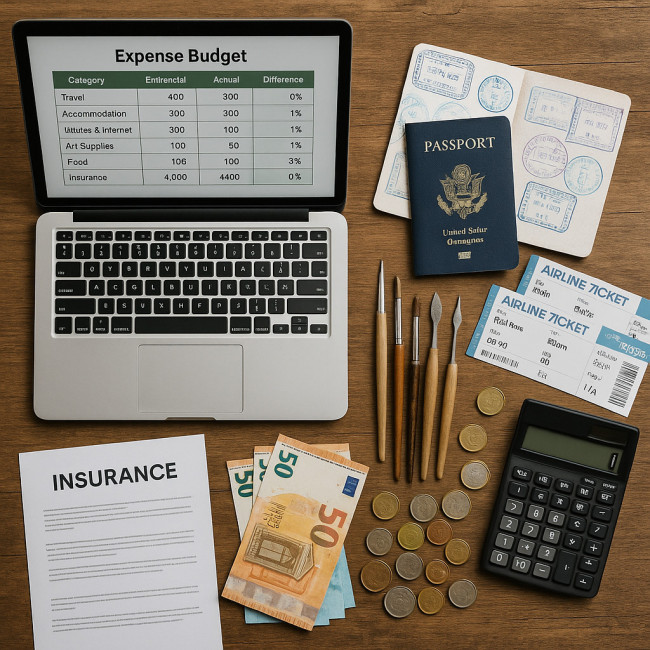Creative residencies abroad: evaluate costs, funding options, and cultural fit
Dreaming of an inspiring studio on another continent? This guide helps you compare costs, secure funding, and assess cultural fit so your next creative residency abroad fuels both your craft and your career.
Why pursue a creative residency abroad?

From fresh perspectives to new professional networks, a creative residency abroad delivers benefits you rarely find at home. You gain uninterrupted time, specialised facilities, and mentors versed in local techniques. These advantages can accelerate your portfolio, as illustrated by glass artists who travel worldwide for new methods. Beyond the studio walls, immersion in unfamiliar streets, cuisines, and sounds can push you to experiment with new palettes, rhythms, or narrative structures, leading to breakthrough bodies of work that resonate with global audiences.
Break down true residency costs

Before applying, list every line item—programme fees, housing, travel, materials, visas, insurance, and day-to-day living. Hidden charges can inflate a “low-fee” opportunity by 40 %. Talk to alumni and request a sample contract; many discover unexpected workshop surcharges, cleaning deposits, lab-access key fees, or peak-season rent hikes buried deep in the fine print. Building a detailed spreadsheet now prevents panicked fundraising when deadlines loom.
Typical budget categories
- Programme fees: Tuition, studio usage, admin costs.
- Accommodation: On-site dorms, rented rooms, or host families.
- Travel: Flights, ground transport, extra baggage for tools.
- Materials: Local sourcing may be cheaper—verify availability.
- Visas & permits: Artist visas often require proof of funds and insurance.
- Insurance: Health, liability, and artwork transit coverage.
- Daily living: Food, local transport, cultural activities.
Cost comparison table
| Residency type | Average monthly fee (€) | Accommodation included? | Materials subsidy | Additional costs to expect |
|---|---|---|---|---|
| Government-funded EU residency | 250 | Yes | Up to 300 | City tourism tax |
| Private foundation in North America | 800 | No | None | Local transport |
| University partnership in Asia | 0 | Yes | Lab access | Visa extensions |
| Artist-run space in Latin America | 350 | Yes | Partial | Import duty on equipment |
| Remote rural hub in Africa | 150 | Yes | None | Satellite internet |
Five funding routes that work
- Grants & scholarships. National arts councils, EU Erasmus+, and private foundations cover most or all expenses. Start with the tactics in this grant-focused residency guide.
- Crowdfunding. Pre-sell limited prints or host virtual studio tours. See how designers pre-test demand in crowdfunding capsule collections.
- Corporate partnerships. Tech firms or eco brands fund creatives aligned with their CSR goals. Pitch using clear ROI and audience metrics.
- University exchanges. Enrol in short modules that embed creatives in labs without tuition fees.
- Self-funding with tax relief. Many countries let you deduct professional development costs. Log every receipt.
Assess cultural fit before you apply
“Good vibes” are not enough. Use these criteria to judge whether a creative residency abroad aligns with your values and work style.
Key cultural factors
- Community expectations: Daily communal meals vs independent work time.
- Critique style: Formal panels or casual peer feedback.
- Local engagement: Mandatory workshops with residents? Public exhibitions?
- Language: English-friendly or immersion in the local tongue.
- Sustainability: Does the programme align with your eco principles? If yes, mirror approaches found in sustainable sourcing plans.
Due-diligence checklist
- Read past participants' blogs or vlogs.
- Join programme social channels and observe dialogue.
- Ask for mentor-to-resident ratios and studio opening hours.
- Clarify intellectual property rights on work created.
- Confirm safety measures if you work with hazardous materials.
Application strategies that stand out
Residency panels review hundreds of portfolios. Increase acceptance odds with concise proposals and proof of impact.
Structure a winning proposal
- Context: One paragraph linking your practice to the host's mission.
- Project plan: Objectives, milestones, and community engagement.
- Budget: Transparent sheet matching requested funds to outputs.
- Portfolio highlights: 5–7 works showing evolution and relevance.
- Outreach plan: How you will share results—exhibitions, articles, or publishing on platforms such as Artfolio's professional development hub.
For inspiration on framing budgets, note the template used by glass innovators in successful grant proposals.
Make the most of your residency
Secured your spot? Convert the experience into long-term value.
- Network intentionally: Schedule one coffee each week with local curators.
- Document daily: Short video logs or sketches keep remote supporters engaged.
- Publish insights: Guest articles, podcasts, or an online exhibition boost visibility.
- Plan re-entry: Book a local show at home before your return to maintain momentum.
Interactive readiness quiz
FAQ
- How far in advance should I apply for a creative residency abroad?
- Most programmes open applications 6–12 months before the start date. Early submission allows time for funding decisions and visa processing.
- Can I bring my family or partner?
- Some residencies offer family housing, while others insist on solo participation. Always confirm accommodation rules before committing.
- What if my project changes once I arrive?
- Residencies value flexibility. Inform your coordinator and outline how adjustments still meet original objectives.
- Will the residency take ownership of the work I create?
- Policies vary. Many claim non-exclusive exhibition rights for promotional use, but you retain copyright. Read the contract carefully.
- Do I need to ship supplies in advance?
- If you use specialised materials, shipping ahead can save time. Factor customs fees and allow at least four weeks for international freight.
Next steps
Short-list three programmes, draft a funding matrix, and contact past residents this week. By following the strategies above, your creative residency abroad will be financially viable, culturally enriching, and career-defining.
Ready to turn plans into reality? Subscribe for more residency insights or share this guide with a fellow creative who needs the nudge.











